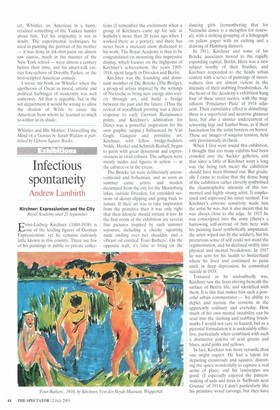Infectious spontaneity
Andrew Lambirth
Kirchner: Expressionism and the City Royal Academy until 21 September -El rnst-Ludwig Kirchner (1880-1938) is Lone of the leading figures of German Expressionism, yet he remains curiously little known in this country. There are few of his paintings in public or private collec tions (I remember the excitement when a group of Kirchners came up for sale at Sotheby's more than 20 years ago when I worked there as a porter), and there has never been a museum show dedicated to his work. The Royal Academy is thus to be congratulated on mounting this impressive display, which focuses on the highpoint of Kirchner's achievement, the years 19051918, spent largely in Dresden and Berlin.
Kirchner was the founding and dominant member of Die Brucke (The Bridge), a group of artists inspired by the writings of Nietzsche to bring new energy into society through art, and build a bridge between the past and the future. (Thus the revival of woodblock printing was a direct response to early German Renaissance prints, and Kirchner's admiration for Durer was a powerful inspiration for his own graphic output.) Influenced by Van Gogh, Gauguin and primitive art. Kirchner, with fellow bridge-builders NoIde, Heckel and Schmidt-Rotluff, began to paint with great dynamism and expressiveness in vivid colours. The subjects were mostly nudes and figures in action — at the cabaret or in the circus.
The Briicke lot were deliberately unconventional and bohemian, and as soon as summer came artists and models decamped from the city for the Moritzburg lakes, outside Dresden, for extended sessions of skinny-dipping and going back to nature. If their art was to take inspiration from the primitive then it was only right that their lifestyle should imitate it too. In the first room of the exhibition are several fine pictures inspired by such summer sojourns, including a cheeky squatting nude smiling over her shoulder, and a vibrant oil entitled Four Bathers'. On the opposite wall, it's time to bring on the dancing girls (remembering that for Nietzsche dance is a metaphor for renewal), with a striking grouping of a lithograph on yellow paper with an etching and a drawing of Hamburg dancers.
In 1911, Kirchner and some of his Briicke associates moved to the rapidly expanding capital, Berlin. Here was a new subject worthy of their brushes, and Kirchner responded to the heady urban context with a series of paintings of streetwalkers that are almost violent in the intensity of their stabbing brushstrokes. At the heart of the Academy's exhibition hang four of these street scenes, with the magnificent 'Potsdamer Platz' of 1914 adjacent. Their cumulative effect is disturbing: there is a superficial and neurotic glamour here, but also a sinister undercurrent of scissoring legs and feather boas, as if their fascination for the artist borders on horror. These are images of singular tension, held only provisionally in check.
When I first went round this exhibition, I thought that too many exhibits had been crowded into the Sackler galleries, and that since a little of Kirchner went a long way (he being rich meat) the exhibition should have been thinned out. But gradually I came to realise that the dense hang of the exhibition rather cleverly symbolised the claustrophobic intensity of this tormented and highly strung artist. It emphasised and expressed his inner turmoil. For Kirchner's extreme sensitivity made him the artist he was, but it also meant that he was always close to the edge. In 1915 he was conscripted into the army (there's a harrowing self-portrait of him here with his painting hand symbolically amputated: the artist wiped out by the soldier), but his precarious sense of self could not stand the regimentation, and he declined swiftly into physical and mental breakdown. In 1917 he was sent for his health to Switzerland where he lived and continued to paint until, in deep depression, he committed suicide in 1938.
Tortured as he undoubtedly was, Kirchner saw the fears stirring beneath the surface of Berlin life, and identified with them. It is this that makes him such a powerful urban commentator — his ability to depict and sustain the tensions in the apparently ordinary and everyday. How much of his own mental instability can be read into the slashing and stabbing brushmarks I would not care to hazard, but as a pictorial formulation it is undeniably effective, particularly when combined with such a distinctive palette of acid greens and blues, acrid pinks and yellows.
In fact, Kirchner was more versatile than one might expect. He had a talent for depicting crossroads and squares, distorting the space wonderfully to capture a real sense of place, and his landscapes are good. (I especially enjoyed the patternmaking of sails and trees in 'Sailboats near Grunau' of 1914.) I don't particularly like his primitive wood carvings, but they have a definite presence. Even humour makes an occasional appearance: in the proudly protuberant buttocks of the unicycle rider, or in the black chalk drawing `Senta and Marzella Nude with Roller Skates'.
Yet it is as a draughtsman and graphic artist that Kirchner really excels. He draws with infectious spontaneity. His prints are extraordinary: intentionally crude but unfailingly inventive — look, for instance, at the superb series of colour woodcuts with monotype inking, done to illustrate Peter Schlemihl's Wondrous Story. And his self-portraits, which are harrowing in their lack of self-deception. He was as at home in lithography as in woodcut. The selection of sketchbooks. coloured-crayon postcards and some of his own photographs add a further dimension to our appreciation of an artist who, at great personal risk, set out to capture what he called 'the absolute melancholy of big city streets'.



































































 Previous page
Previous page